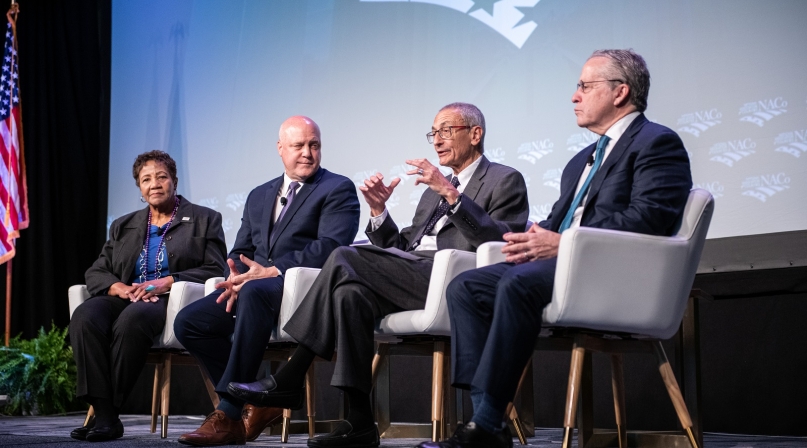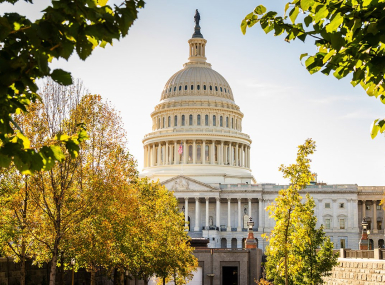White House advisors chart economic path forward in General Session

Key Takeaways
The Biden administration’s chief economic emissaries outlined changes in store for the American economy and how counties fit into the picture, while speaking Monday to a General Session audience.
Mitch Landrieu, who is managing implementation of the Bipartisan Infrastructure Law (BIL), has seen a lot he likes in his portfolio, along with the American Rescue Plan Act (ARPA) and the Inflation Reduction Act (IRA).
“This is the most comprehensive, well-thought-out approach to fixing what has been wrong with America in my lifetime,” he said. “You will not see — whether by design, or good fortune or luck — another overarching theme that fits together really nicely, beginning with the bill that Gene’s [Sperling] overseeing for the rescue plan, to the work that I’m doing in the infrastructure law, to the work that John’s (Podesta) doing with the Inflation Reduction Act and the CHIPS Act.
“It’s all part of the same arc, of how you rebuild America from the bottom up and the middle out.”
Sperling, who has overseen ARPA implementation, said the plan’s attention to flexibility should make it a model for the federal government going forward. The plan awarded $65.1 billion directly to counties to mitigate the effects of the COVID-19 pandemic, including replacing lost revenue. That gave counties the leeway to stabilize their pieces of the country, expand their services to meet increased needs, retain their workforces and fortify their local economic bases in the form of assistance to businesses and nonprofits.
“This model is the best model for a recovery plan ever,” Sperling said. “It was…designed to ensure that we have insurance against the bumps in the road that can happen and all of you had the capacity not just to get back but to, as the president says, build back better.”
The flexibility that allows recipients to spend on anything besides lobbying has been crucial to ARPA’s success, and Sperling tells anyone who asks to look to counties as the test case.
He refuted criticism that ARPA was responsible for inflation, pointing out the favorable inflation rate in the United States, relative to comparable nations.
“I think all of you know, the U.S. is not only having inflation coming down, we’re in the middle of the pack,” he said, noting that the 38 Organization for Economic Co-operation and Development countries averaged 10.3 percent inflation as of November 2022, compared to the 7.1 percent U.S. inflation rate at the same point.
“If we do not let people know how well this model has worked, then shame on us, because the next time they’ll say that was that was a mistake. If not, the next time this happens they’re going to go back to the old model” of sending money through state governments, Sperling noted.
The Inflation Reduction Act will incentivize private sector investments to advance transitions to renewable energy adoption in pursuit of climate change goals.
“It’s a big bill, but it’s a bit different than the other legislation we’ve been talking about,” said Podesta, senior advisor to the president for clean energy innovation and implementation. “Two-thirds of the support for investment is running through the tax code, so it is intended to spur private sector investment in all these clean technologies to create a cycle of innovation to root that investment in the needs of the country.”
Those needs have been collecting in underserved areas for decades, and Podesta said the IRA (Inflation Reduction Act) is oriented toward making investments that are too good to pass up.
“By enhancing these tax credits, it gives the private sector an incentive to pay prevailing wages, to use certified apprentices, to go to places that are often overlooked, left behind and invest there,” he said.
Long-term horizons for incentives will make planning more reliable and Podesta said it was oriented toward local community development strategies.
“Now we’ve got 10 years of certainty and countless households as a result will be able to install rooftop solar, purchase energy efficient appliances like heat pumps, make cost-saving efficiency upgrades, insulation windows and doors,” he said. “We went through a period of time where there was tax credit support for clean power, but it sunsetted every year. It’s very hard to plan big projects.”
Big projects are relative, though, and Landrieu said what may seem like small bridge replacements funded by the BIL could mean the world to a community that is cut off or severely inconvenienced in both commerce and public safety if an off-Interstate-system bridge is out of commission.
“There is a benefit in this bill that says that if you actually invest the money in an off-system bridge, we’ll pay 100 percent of it instead of the 80 percent of it,” Landrieu said. “That's where the incentive comes in from our side, everybody, rural areas understands that.”
Getting some projects done through the BIL, including repairing, replacing, fortifying, upgrading and rethinking myriad infrastructure components — some of which have been neglected for decades due to insufficient resources — takes a modicum of cooperation with states, and for some projects, like the Drinking Water State Revolving Fund, counties have to be active in making their needs known.
“The governors and the state legislators have to come up with a state plan, and you need to be engaged with them to make sure that your county doesn’t let get left behind,” he said of revolving door loans for water resources.”
Attachments
Related News

U.S. Congress releases minibus funding package
U.S. House and Senate appropriators introduced a “minibus” appropriations package containing Fiscal Year (FY) 2025 Interior-Environment, Commerce-Justice-Science and Energy-Water spending bills.

Counties and Railroads: Shared Priorities for the Next Surface Transportation Bill
County leaders from across the country have a vital opportunity to ensure their infrastructure priorities are front and center.

House reintroduces bipartisan legislation to level playing field for rural communities
House reintroduced the Rural Partnership and Prosperity Act, bipartisan legislation intended to advance economic development in rural counties and overcome barriers to obtaining federal funding and resources.
